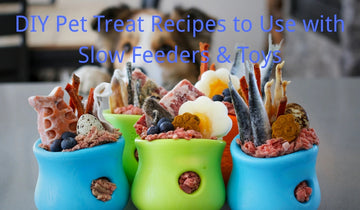Is mealtime over in seconds at your house? Pairing slow feeders and puzzle toys with simple, wholesome DIY treats can turn rushed eating into calm, brain-engaging enrichment. Below you’ll find science-backed tips, safety notes, and 8 easy recipes—for both dogs and cats—that work beautifully in mazes, lick mats, balls, and stuffable toys. Every recipe uses common pantry ingredients and includes quick prep, storage, and feeder tips.
Why DIY Treats + Slow Feeders Work
-
Slower eating → better digestion: Thick textures and small treat sizes naturally limit gulping.
-
Mental enrichment: Sniffing, licking, nudging, and pawing provide stress-relieving brain work.
-
Flexible nutrition: You control ingredients for sensitivities and calorie targets.
Safety first: Avoid xylitol, chocolate, onions/garlic, grapes/raisins, high salt, and excess fat. Introduce new foods gradually. Treats should be ≤10% of daily calories (adjust regular meals accordingly).

8 Easy, Healthy Recipes
US measures given first; metric in ( ). Bake times are guides—ovens vary. Cool fully before use.
1) Blueberry–Yogurt Lick-Mat Bark (Dogs)
What it’s for: Lick mats, maze plates
You’ll need:
-
1 cup (240 g) plain Greek yogurt
-
¼ cup (40 g) blueberries (fresh or frozen, chopped)
-
1 tbsp unsalted peanut butter (xylitol-free)
How: Mix yogurt + PB; spread thinly across a lick mat; sprinkle berries; freeze 2–3 hrs.
Feeder tip: For beginners, don’t freeze solid—semi-soft keeps motivation high.

2) Pumpkin Oat “Nibble Bits” (Dogs)
What it’s for: Treat balls, puzzle boards
You’ll need:
-
½ cup (120 g) canned pumpkin (unsweetened)
-
1 cup (90 g) quick oats
-
1 egg
How: Mix to a sticky dough. Pinch pea-size pieces onto a lined tray. Bake 350°F (175°C) for 12–15 min.
Feeder tip: Drop a few bits into each compartment so your dog must forage methodically.

3) Bone Broth Gummy Cubes (Dogs & Cats)
What it’s for: Lick mats, bowls with ridges
You’ll need:
-
1½ cups (360 ml) low-sodium chicken or beef broth
-
2 tbsp (18 g) unflavored gelatin
How: Warm broth; whisk in gelatin to dissolve. Pour into silicone molds; chill 2–3 hrs to set.
Feeder tip: Press cubes into a slow feeder’s grooves to extend licking time.

4) Tuna & Chia Drops (Cats, also dog-friendly)
What it’s for: Rolling treat toys, puzzle sliders
You’ll need:
-
1 can tuna in water, drained (approx. 5 oz/142 g)
-
1 egg
-
1 tbsp chia seeds
-
2–3 tbsp oat flour (as needed)
How: Blend to a thick batter; pipe pea-size dots on a lined tray. Bake 325°F (165°C) for 12–14 min.
Feeder tip: Dry “drops” flow easily through cat treat mazes without jamming.

5) Sweet Potato & Sardine Coins (Dogs & Cats)
What it’s for: Maze bowls, snuffle mats
You’ll need:
-
1 cup (230 g) mashed cooked sweet potato
-
1 tin sardines in water, drained (3.75 oz/106 g)
-
¼ cup (30 g) rice flour (or oat flour)
How: Mash, mix, and form nickel-size coins. Bake 300°F (150°C) for 20–25 min until firm.
Feeder tip: Hide coins at multiple “difficulty levels” (surface vs. deeper cavities).

6) Kefir–Banana Pupsicles (Dogs)
What it’s for: Stuffable toys, summer lick mats
You’ll need:
-
¾ cup (180 ml) plain kefir (or lactose-free yogurt)
-
1 ripe banana, mashed
-
Optional: 1 tsp finely chopped parsley
How: Blend, pour into molds or directly into a toy; freeze 3–4 hrs.
Feeder tip: Freeze in layers (kefir → banana → kefir) to make progress slower and more rewarding.

7) Chicken & Rice Puzzle Poppers (Dogs)
What it’s for: Sliding puzzles, scatter feeding
You’ll need:
-
½ cup (70 g) finely shredded cooked chicken
-
½ cup (85 g) cooked rice
-
1 egg
-
1 tbsp finely chopped parsley
How: Mix; pack into a mini-muffin tray; bake 350°F (175°C) for 10–12 min. Cool and cube.
Feeder tip: Alternate “poppers” with regular kibble so your dog keeps searching.

8) Cat Creamy Salmon Swirls (Cats)
What it’s for: Lick mats, shallow mazes
You’ll need:
-
¼ cup (60 g) canned salmon, finely flaked
-
¼ cup (60 g) lactose-free plain yogurt or water
-
½ tsp salmon oil (optional)
How: Whisk to a smooth, spreadable paste; smear thinly on a lick mat; chill 30–60 min.
Feeder tip: Draw a spiral pattern—the changing line thickness creates varied effort points.

How to Load Slow Feeders & Toys Like a Pro
-
Layer textures: Wet base (yogurt/pumpkin) → sprinkle dry bits (oat nibble, drops) → drizzle a little broth → freeze.
-
Vary difficulty: Start soft (unfrozen, shallow) → progress to frozen/stacked layers → add tighter lids/sliders.
-
Mix wet + dry: Prevent “vacuum eating” by interspersing crunchies with sticky layers.
-
Portion smartly: Time your session to 10–20 minutes; remove leftovers and wash thoroughly.
Storage & Substitutions
-
Refrigerate baked treats up to 4 days; freeze up to 2 months.
-
Swap ideas:
-
Oat ↔ rice flour (GF)
-
Kefir/yogurt ↔ lactose-free yogurt or water for sensitive pets
-
Sardine ↔ mackerel (in water, drained)
-
Pumpkin ↔ mashed butternut or carrot purée
-
Troubleshooting
-
Gives up quickly? Reduce difficulty: thinner layers, shorter freeze, larger treat sizes.
-
Still gulping? Use deeper mazes/elevate the bowl and spread thick layers to slow intake.
-
Sensitive stomach? Introduce one new ingredient at a time; keep portions small; monitor stools.

Make Mealtime the Best Part of Their Day
Ready to transform rushed eating into calm, enriching fun with healthy pet snacks? Pair these slow feeder recipe ideas with a well-designed feeder or interactive toy and watch your pet’s digestion, mood, and focus improve.
👉 Explore slow feeders and enrichment toys here: https://nokaaurorastone.com





